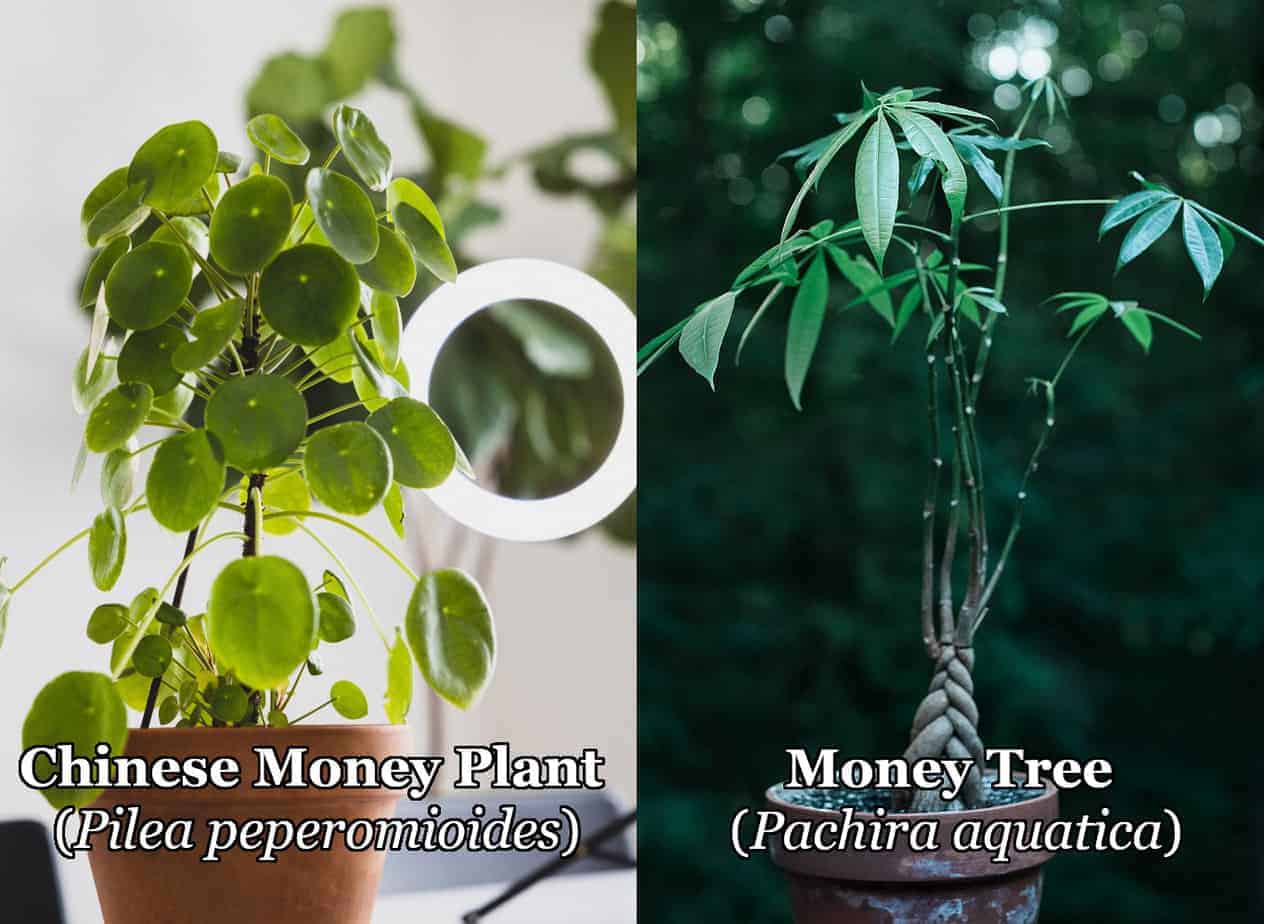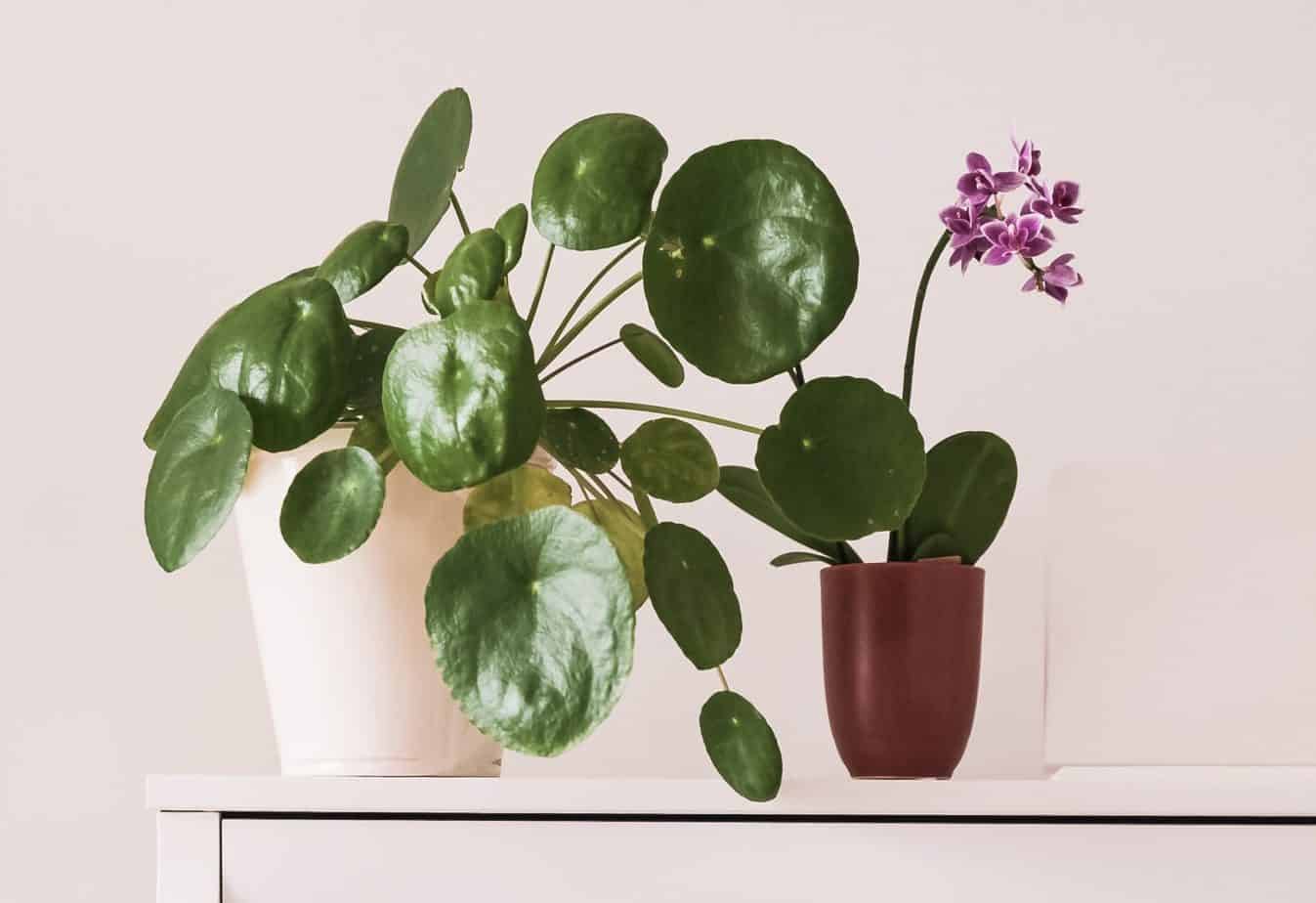The Chinese money plant (Pilea peperomioides) is known by many names, such as the pancake plant and UFO plant, and is a popular houseplant all over the world. Not only is this because of its unique growth habit, but also because of how easy it is to grow and propagate.
On this page:
Chinese Money Plants: Overview and Background
Species Name: Pilea peperomioides
Origin: Southwestern China
Height: 12+ inches
Growth Habit: Shrub-like, droopy, oval leaves, and very long petioles (leaf stalks) attached near the center of each leaf
Chinese money plants are native to the mountainous subtropical region of Southwestern China. It naturally grows as a forest understory plant, developing into almost a kind of ground cover along the damp, rocky, mountain slopes.
Under normal growing conditions in a small pot, it can easily get up to 12 inches tall, but mature plants can get taller, reaching over 24 inches in height in some cases.
Chinese money plants produce small white flowers, but mostly reproduce asexually, growing baby plants from runners underneath the soil, similar to strawberries.
Because it’s evolved to grow in less than ideal conditions, and it can be propagated very easily, it makes an excellent houseplant.
Important Note: The Chinese money plant (Pilea peperomioides) is often confused with the money tree (Pachira aquatica), which is a completely different plant. Pilea peperomioides is native to China, while Pachira aquatica is native to South America, but both are popular houseplants in East Asia and grown for export, which leads to confusion. Not to mention the fact that there are several other plants called “money plants”, as well.

Best Soil for Chinese Money Plants
Chinese money plants thrive in rich, well-draining potting mix. Avoid using regular garden soil, top soil, or other heavy soils.
Any store-bought potting mix will work, and you can make your own potting mix. Recommended ratios vary, but an all-purpose recipe is mixing approximately 1/3 compost, 1/3 peat moss or coco coir, and 1/3 perlite or vermiculite. You can get away without using compost (like using mostly peat moss or coir with some perlite/vermiculite) but you will need to add extra fertilizer into your mix.
Pilea peperomioides is not picky about soil, since it naturally grows on rocky mountain soil. The key is to make sure it’s well-draining, otherwise your money plant’s roots will drown. Evenly moist, but not soggy potting mix is best. Overwatering is one of the most common reasons why Chinese money plants die.
Water Requirements of Pilea peperomioides
Chinese money plants grow best in evenly moist potting soil that is not sopping wet. If roots are submerged in water or are in waterlogged soil, they will drown, die off, and start to rot. Some houseplants like the common golden pothos (Epipremnum aureum), can thrive in just water, but not your Pilea.
At the same time, don’t let the soil completely dry out. This can cause leaf drop and if the roots completely dry out, it can kill your plant.
One way to check if your Pilea peperomioides needs water is with the finger test. For mature Chinese money plants, push your finger in 1 to 2 inches into the soil. If it’s dry, you need to water them. If you can still feel moisture, you don’t need to water yet. For baby plants, check the soil about 1/2 inch deep for moisture.
Do Chinese Money Plants Like Humidity?
Chinese money plants are resilient and can tolerate a wide range of environments (which is partly why they are a great houseplant) but they do not grow as well in very dry air.
While it may seem counterintuitive, despite Chinese money plants being unable to tolerate soggy, wet soil, they thrive in high humidity.
If you have dry air in your home, either because it’s the winter months or you live in a desert climate, you can still grow Pilea peperomioides. Chinese money plants like to be misted, so you can mist your plants daily all around the leaves and stem.
Light Requirements for Chinese Money Plants
Since Pilea peperomioides is an understory plant, it naturally grows in shady environments. However, your Chinese money plants will grow best in bright, but indirect light. Direct sunlight may scorch the leaves and stress your plants.
To get an idea of what “bright, but indirect light” means, an example would be between 3 and 6 feet of a south-facing window (north-facing if you’re in the southern hemisphere).
Your Pilea plants will also grow in shadier locations, but will grow more slowly and the leaves will turn a darker green (which may be desirable).
Can You Grow Chinese Money Plants Under Grow Lights?
Chinese money plants respond extremely well to artificial light, either as supplemental light near a window or as the main source of light for your plants.
Because they aren’t very fussy about light, you do not need powerful grow lights. Cheap tabletop LED grow lights or even fluorescent lights will suffice. Just ensure that the leaves are not touching the bulbs, which can scorch the leaves, and are at least a few inches below the light.
Leaving the light on for anywhere from 8 to 14 hours a day seems to be the sweet spot for many Pilea growers. If you are using grow lights as a supplement to indirect sunlight, you can keep the lights on even less.
Propagating Chinese Money Plants
Pilea peperomioides naturally grows runners under the soil, which sprout baby Chinese money plants. You can leave them in the pot or you can give your main plant some extra breathing room and remove them.
Baby Pilea plants can be replanted in separate pots and grow into their own full-sized Chinese money plants. The best baby plants for propagation have at least 5-7 leaves. The bigger the baby plant, the more likely it will survive being removed from the mother plant.
How to Propagate Chinese Money Plants (the Easy Way)
1. Loosen the soil around the base of the baby Chinese money plant you want to propagate. At the base of the stem, you will see the runner, which looks like a thick root.
2. Cut the small plantlet from the mother plant while leaving at least an inch of the runner attached.
3. Either place the runner in water for 2 weeks or plant into a small pot with moist potting soil. If there are roots already growing out of the runner, you can plant directly in soil kept evenly moist to reduce transplant shock. Otherwise, you can submerge the runner in water for at least 2 weeks until new roots form.
4. If you’ve rooted your baby plant in water, transplant to moist potting soil after you see several new roots growing.
5. Enjoy your new Pilea plant!
Chinese Money Plant Care: Repotting
Pilea peperomioides can either be repotted into the same pot, but with fresh potting mix, or planted in a slightly larger pot. During this time, you can also pluck out any baby plants you want to propagate.
When repotting, carefully tease out your Chinese money plant by holding it at the base of the stem while gently tipping over the pot. Don’t pull the stem directly as you could damage it. If your Pilea needs repotting, all the roots and potting mix should come out as one root ball. If you’re growing it in a plastic pot, you can squeeze the sides a bit to help the root ball release more easily.
Remove any baby plantlets you want to propagate, leaving only the mother plant. Then, carefully loosen the soil around the roots of the mother plant while trying not to damage them.
Refill the same pot with fresh potting mix or upgrade to a slightly larger pot, which will give more room for your Pilea to grow larger. Water well after repotting to reduce transplant shock.
How Often Should I Repot My Chinese Money Plant?
Pilea should not be repotted often, but generally every 2 years or so benefits from a pot upgrade. If the root ball is tight and the plant looks root bound, it’s a good time to repot.

Frequently Asked Questions Related to Growing Chinese Money Plants
Do Chinese Money Plants Like to Be Root Bound?
Not really. Pilea can tolerate being root bound, but grows best when roots have room. However, if you want to keep your Chinese money plant small, then you can keep it in a small pot and just repot into the same size pot every 2 years.
How Big Do Chinese Money Plants Get?
Pilea normally reaches around 12 inches in height, but mature plants can grow to over 2 feet tall when taken care of. Large money plants may require a small stake to keep them upright.
How Fast Do Chinese Money Plants Grow?
It depends on several factors: environment, light, nutrients, and starting plant size. Baby plants may take over a month to get established and put out new growth. However, mature plants may quickly put on new foliage, with some Pilea owners seeing their plants double in size every year.
Do I Have to Fertilize Chinese Money Plants?
If you are using fresh, store-bought potting soil, it already has enough fertilizer in it to support growth for over a year. However, Chinese money plants benefit from extra feeding periodically. Using a balanced liquid fertilizer, fed once every 1 to 2 months, is enough to keep your Pilea putting on lush new growth. It’s always better to underfertilize than overfertilize.
